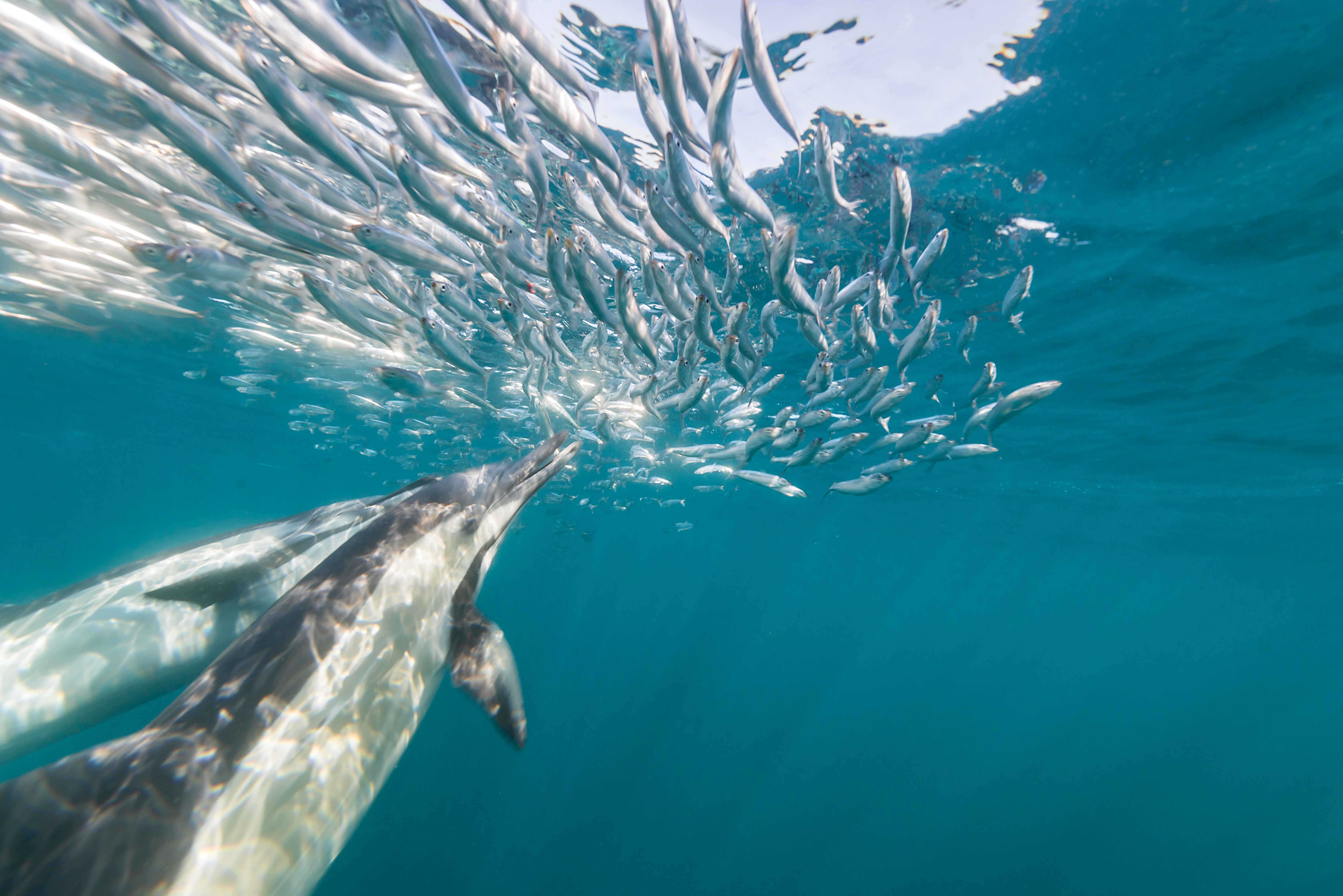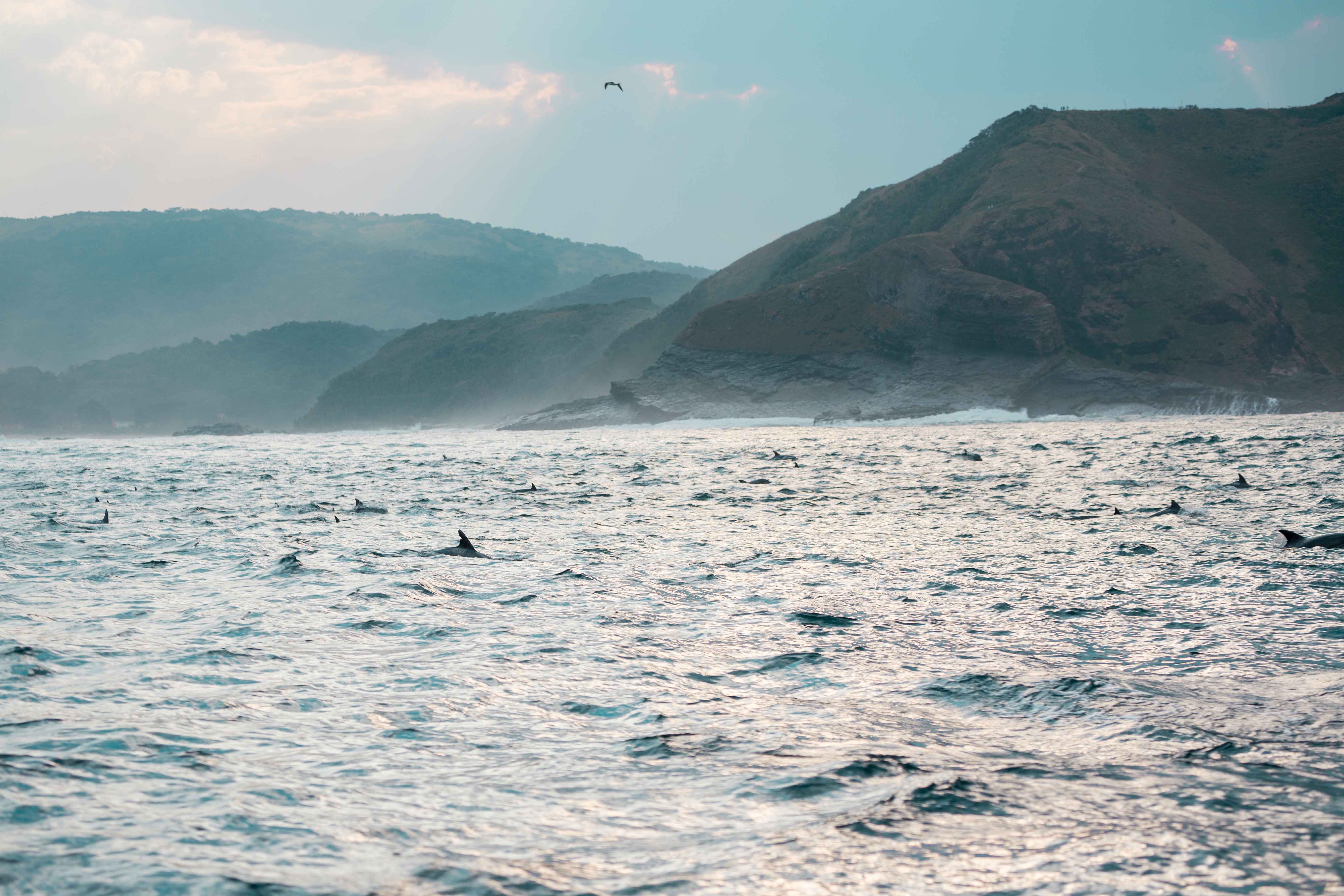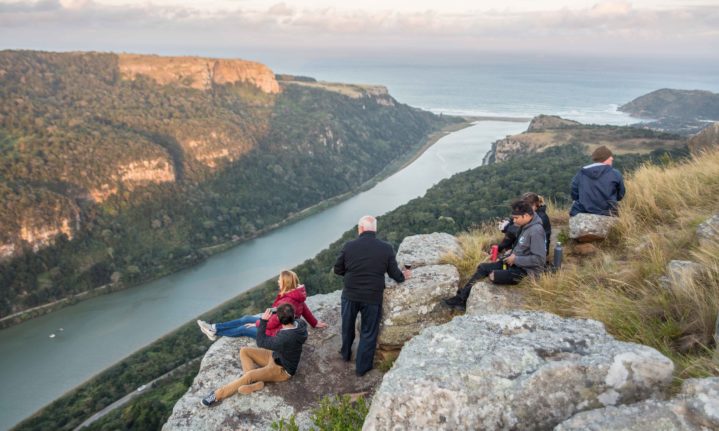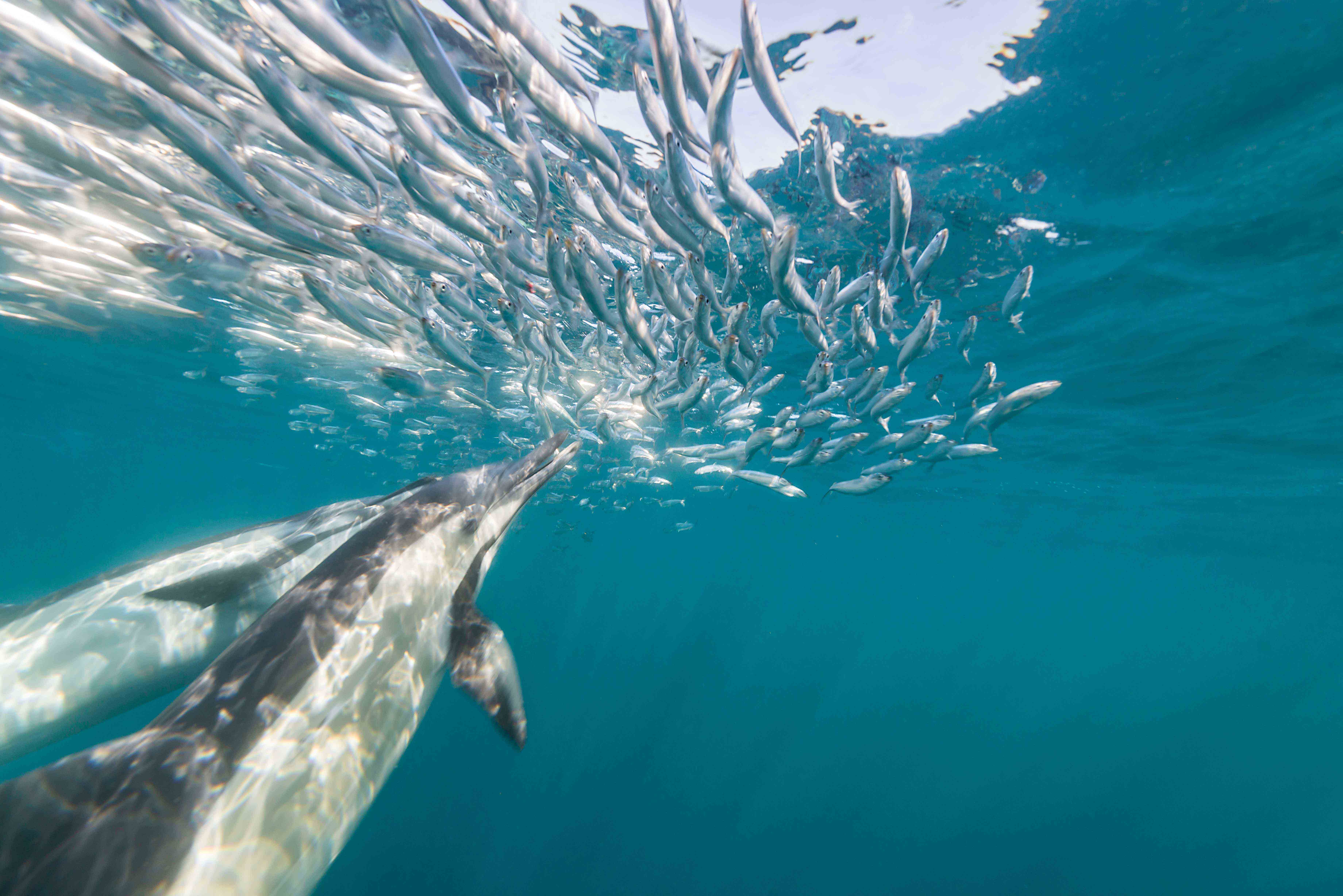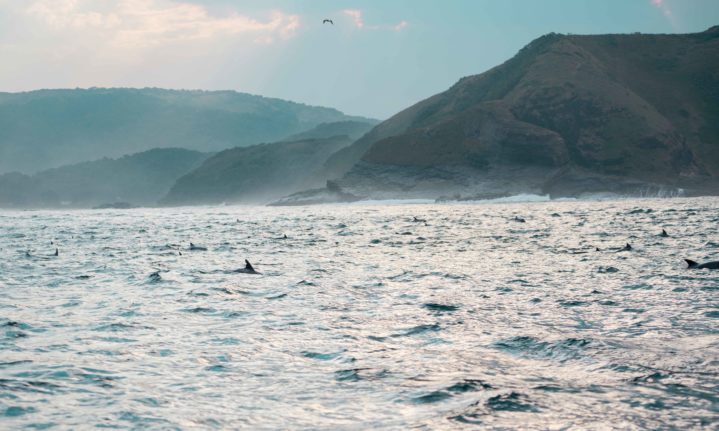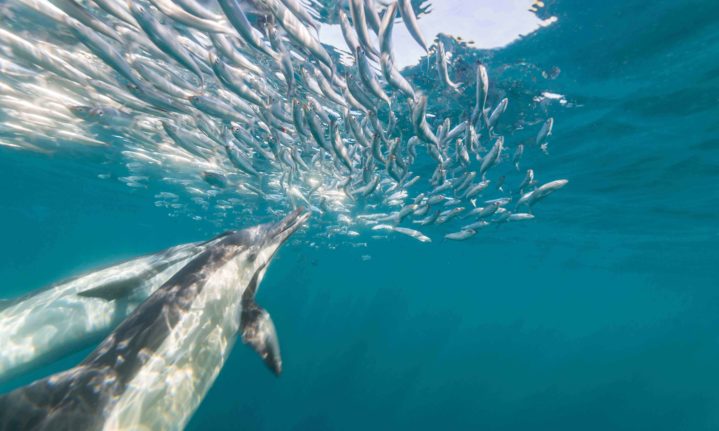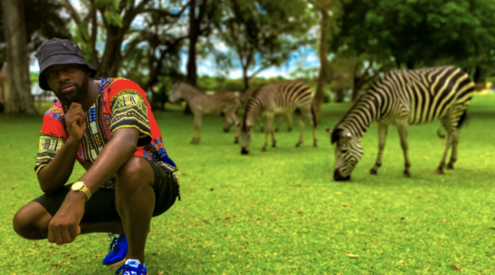It’s dubbed the greatest shoal on Earth – billions of sardines making an annual pilgrimage up South Africa’s east coast, trailing marine predators in their wake. Getaway‘s Online Manager Elise Kirsten went swimming with the ‘fishies’ off Port St Johns.
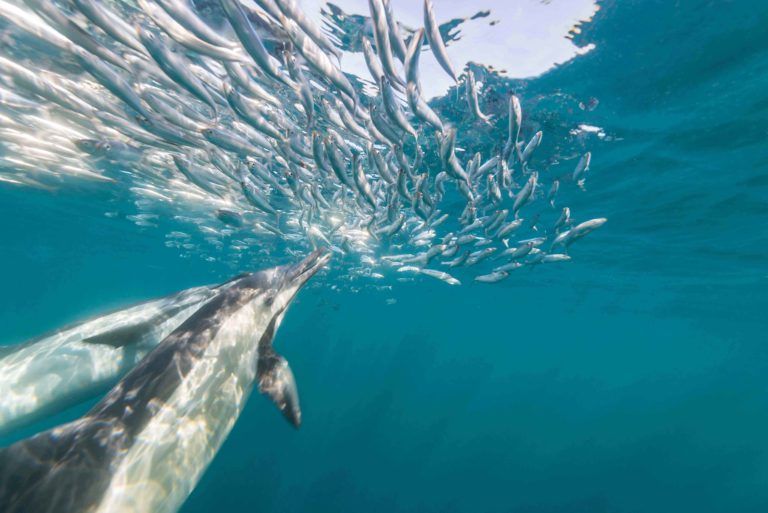
Live fast, die young: the Sardine Run starts near Port Elizabeth in April. The annual catch drops from 10,000 tons along the Eastern Cape coast, dwindling to several-hundred tons when the shoals reach KwaZulu-Natal. Image: Gallo/Getty Images
Nausea clawed at my throat as I bounced like a ping-pong ball against the inflatable tube of the rubber duck. I was hunkering as close to the bow as I could to avoid the smell of diesel, my hands clutching the rope. The breakfast I’d so enjoyed earlier was now at sea in my stomach.
Our duck heaved skyward off the lip of each swell and descended just as rapidly. A cold front had swept over Port St Johns the previous night and there was a marked difference from the previous day’s calm.
Up, down, bam, bam, bam, we powered across the chop, chasing millions of bait fish that made the surface of the ocean shimmer as their oily bodies agitated the water. We were in the midst of the Sardine Run, the largest migration of fish in the world. It occurs in the winter months when sardines, having spawned in the cold waters off Agulhas Bank, head north, riding the cool, nutrient-rich currents. And I had joined Offshore Africa, the only specialist operator permanently based in Port St Johns, for full immersion in this crazy natural phenomenon.
Rob Nettleton, our skipper, cut the engine to scout the horizon for Cape gannets – tell-tale sign of a bait ball. Then Zulu Dowsett, our eye in the sky, radioed Rob from his gyrocopter to indicate action further south. ‘There’s a small ball forming at Rame Head just behind the waves, with a couple of big sharks and some common dolphins,’ he reported.
The twin Yamaha 85hp motors roared to life, churning the sea behind us like clotted cream as the inflatable charged south at full throttle. To starboard, we were flanked by sandstone cliffs with rounded grassy tops, scattered with rondavels and other colourful dwellings. Rame Head lay ahead.
‘This is where the dolphin surfing sequence for BBC’s Blue Planet II was filmed,’ said Rob as he cut the engine.
Vesagan Mudaley (fondly referred to as Ves) – a freediver, spearfisher, scuba instructor, and water baby – went over the side and scouted the area, holding a shark prodder (a stick with dubious deterring qualities) out in front of him.
Gannets marked the spot, dive-bombing and filling their beaks with silvery fish. The fins of common dolphins cut through the water like blades. Ves gave the all-clear for us to enter the water with divemaster Richie O’Connell, who was tasked with herding us from behind like oceanic sheep.
Any hesitation about dropping into the sea to swim unprotected in the middle of the sharks’ and dolphins’ buffet was swiftly dispelled – I was desperate to get rid of my nausea by escaping the vessel. The 22°C water flooded my suit and I finned hard in the choppy sea, panting through my snorkel and heading in the direction of Vesagen and his magic wand.
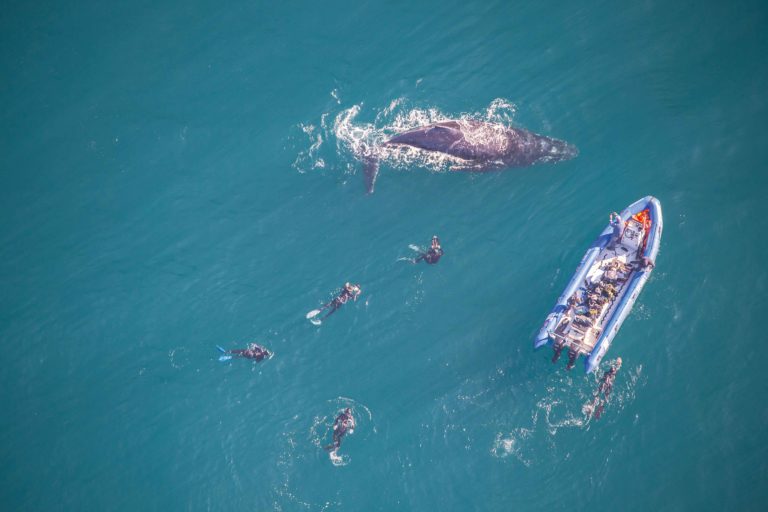
An inquisitive young humpback whale takes a playful break in its migratory journey from the feeding grounds in Antarctica to the breeding waters off Mozambique. Image: Elise Kirsten
Rex Baker, a portly and adventurous octogenarian from Atlanta, Georgia, was the last off the boat. I’d met him the previous morning when he’d asked if I could help zip up his wetsuit. ‘Getting me into this suit is like stuffing a sausage into its skin,’ he quipped.
As I neared the action, I lifted my head and watched fascinated by the skirmish as gannets dived and dolphins sliced through the water from below. Swimming down, I was mesmerised by the dolphins all around me. They swam deeper, clicking and squeaking and then shot around the ball of sardines, corralling them with swift, zigzagging movements. There was frenetic energy in the water as the shimmering, dancing mass of fish darted evasively from side to side.
I couldn’t see the sharks but Ves, who could propel himself deeper with his long fins, confirmed that he’d spotted one of them below us. Much like the ill-fated sardines, I had a false sense of safety in our group, and didn’t feel fear, just awe at being part of such thrilling ocean activity.
After we and the dolphins had had our fill, we swam back to the boat and found Rex on board already. ‘I headed back after a minute or two. My motto is: if it don’t feel right don’t do it,’ he said.
His decision was not entirely surprising. This Sardine Run expedition wasn’t a leisurely jaunt with a spot of snorkelling or scuba diving in a sheltered cove off a tropical beach. The conditions required a fair degree of fitness, finning hard to keep up with dolphins and whales, and the agility to get on and off the boat continually.
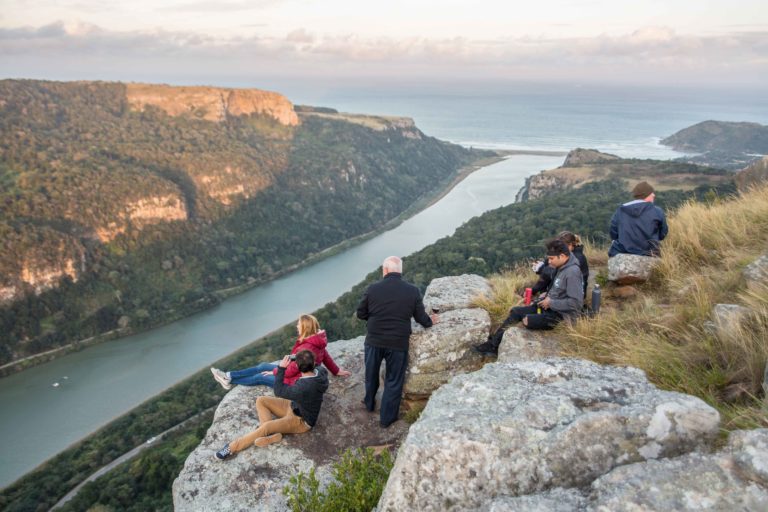
The winding road to Port St Johns airstrip is worth it for the sunset views over the Umzimvubu River. Image: Debbie Smith
The day before, the ocean had been alive with humpbacks, which also migrate up the coast at this time of year but have no interest in sardines. You could face in almost any direction and there’d be a number of them launching their 40-ton bodies out of the water. Two whales engaged in a breaching contest right in front of our boat, although most just cruised by, and we’d slide off the side of the duck for a brief encounter with these gentle creatures.
On another day, an inquisitive young humpback spent more than two hours lazily rolling over, spy hopping and interacting with awestruck snorkellers from our boat. The divers hung around like floating starfish loosely connected to the whale via an invisible cord of fascination.
Sadly, I wasn’t in the water that morning (I wished I could have cloned myself). Instead I was in the sky, with Zulu in his gyrocopter. The open craft provided a great vantage point for a bird’s-eye view of the action. Below us, gannets dived and dolphins corralled the sardines. We saw a Brutus whale with a white-tipped head cruising like a slow-motion torpedo and watched our group of divers swimming with the humpback that wouldn’t leave.
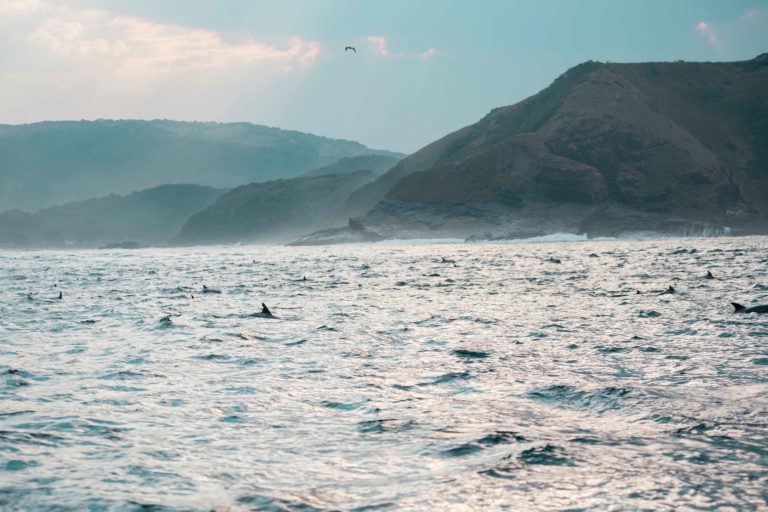
Multiple pods of common dolphins occasionally merge to form a superpod – like this one south of the Umzimvubu mouth. Image: Elise Kirsten
Chatting over supper that night at Port St Johns River Lodge, Rob’s partner Debbie Smith explained the dynamics of the Sardine Run. The continental shelf runs close to the land from Port St Johns to Mbotyi. This creates a deep-water channel near the coast that funnels both the cold water (being pushed north by winter storms) and the sardines, attracting a huge variety of predators and creating an area abundant in marine life. We’d seen so many dolphins (mostly common but some bottlenose too) on our days out, that Ryan Saks, a fellow visitor, described as the ‘impala of the sea’.
On our last afternoon, after a thrilling day on the water and with the wind blowing through my matted, salty hair, we headed back towards the Uzimvubu River. The sun mellowed under a moody sky that promised a thunderstorm. Just then, we happened upon a superpod of common dolphins. Many hundreds of these shiny-bodied cetaceans streamed past, their dorsal fins dipping and rising like hammers inside a piano, playing a silent tune against the backdrop of cliffs.
What a culmination to my adventure. I’d seen the spectacle from the boat, from underwater and from the sky. It will remain one of my favourites and left me with a lingering appetite to do it again.
Plan your trip
Getting there
It’s a five-hour drive from Durban to Port St Johns. Take the N2 to Port Edward, then the R61 via Bizana, Flagstaff and Lusikisiki. Alternatively, you can fly direct from Joburg to Mthatha on Airlink (from R2, 050), then drive the 90 km to the coast. flyairlink.com
When to go
The Sardine Run typically reaches Port St Johns from late June into early July, but nature follows its own timetable and some years are much more prolific than others. Go to offshoreportstjohns.com to find out if the sardines are running.
Stay here
Port St Johns River Lodge is on the banks of the Umzimvubu River. It’s tranquil with palm trees, a river view and cliffside backdrop. There’s a swimming pool, fitness room, good restaurant, and a drying room to leave your wetsuit overnight. Budget rooms from R400 per person sharing; self-catering chalets from R500 per person sharing. 083 441 5366, portstjohnsriverlodge.co.za
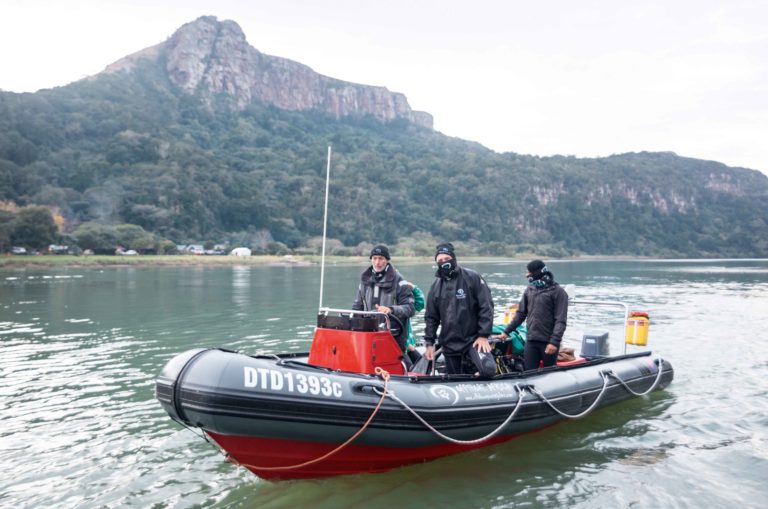
The 7am winter pickup from the lodge jetty is a chilly affair. Image: Elise Kirsten









